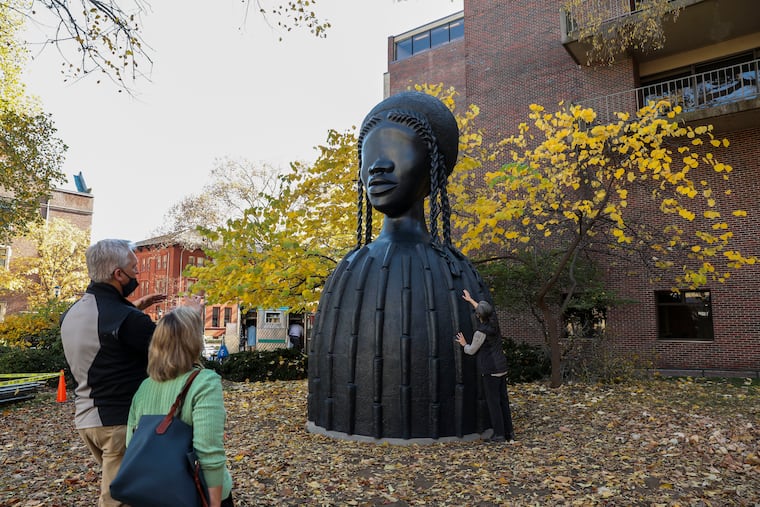Penn installs a 16-foot sculpture of a Black female figure at entrance to campus
Its unveiling comes as the nation welcomes its first Black female vice president-elect and as college campuses hear calls to become more inclusive.

The University of Pennsylvania on Tuesday installed a 16-foot, 5,900-pound bronze-cast sculpture of a Black female figure at its main campus entrance.
Though in the planning for more than a year, its unveiling comes as the United States welcomes its first Black female vice president-elect and as college campuses across the country hear calls to become more inclusive as concern about racial injustice mounts.
“Its enthralling presence of Black beauty with artistic references to the African diaspora will draw the attention of everyone walking or driving past one of the most traveled corners in West Philadelphia,” Penn president Amy Gutmann said of the piece, titled Brick House, which was installed at the 34th and Walnut Streets gateway to the College Green. “And how perfectly fitting it is that we welcome Brick House to our campus at the same time as we redouble our collective efforts to confront issues of racial justice.”
» READ MORE: The making of Simone Leigh's Brick House
The figure, 9 feet in diameter, was created by prominent Black artist Simone Leigh and is the second of its kind. The first is on display on New York City’s High Line. Penn’s edition was a gift from New York City alumni couple Glenn and Amanda Fuhrman.
Fuhrman, 55, an art collector and founder and CEO of Virtru Investment Partners, said he had seen the piece in New York and was struck by its beauty. Leigh had hoped one of the pieces would wind up on a college campus, Fuhrman said. He thought Penn would be an ideal location and reached out to the university.
“It’s sweet poetry that this work is being installed within a week of this country electing its first female vice president and its first vice president of color,” he said. “I think both examples bode well for the future, our children, and for the country at large.”
» READ MORE: Sculptor will be first Black woman to represent US at Biennale
Fuhrman got his undergraduate degree from Penn in 1987 in finance but also had a minor in art history. He got his M.B.A. from Wharton in 1988. His wife majored in diplomatic history and received her degree in 1995. She also has a law degree from Columbia. Neither Penn nor Fuhrman released the price of the sculpture.
The piece features a large head of a Black woman with cornrows atop what appears to be a skirt that also resembles a house and is meant to merge human form with architectural elements.
» READ MORE: Simone Leigh moves into the mainstream
“The sculpture is infused with the architectural concepts and processes taken from West Africa as well as the American South: the Batammaliba architecture from Benin and Togo, the Mousgoum people of Chad and Cameroon, and the restaurant Mammy’s Cupboard, in Natchez, Mississippi,” according to an essay about the New York piece on the Hauser & Wirth gallery website.
The name of the piece, Brick House, was inspired in part by the Commodores song, Leigh told the New York Times in a 2018 interview.
“It was a celebration of black womanhood that we hadn’t really heard,” Leigh, a Chicago native and daughter of Jamaican missionaries, told the Times. “That was what was resonant about it — not necessarily a male gaze but that beauty was associated with mightiness and strength, as opposed to fragility. Being solid.”
Leigh said in a Penn statement: “Brick House is not a portrait. It brings disparate forms together in a way that collapses time. I would describe this way of building sculpture as ‘critical fabulation.’”
The sculpture was cast at a Philadelphia foundry and Leigh spent time in the city in the last year while the work was being done, Fuhrman said. Leigh created the ceramic prototype on a wire mesh frame. It took 9,000 pounds of clay and was cast with 6,000 pounds of bronze. It was transported to Penn on a flatbed truck and was being installed using cranes.
It will sit beside the School of Design and the building that houses the history-of-art department. It is an important addition to Penn’s iconography, said Joann Mitchell, senior vice president for institutional affairs and chief diversity officer.
“It’s the first really prominent piece of artwork that’s being displayed where the artist is a Black woman and particularly one that depicts a woman of African descent,” she said. “In some ways, it’s a pathbreaking move for campus and one that will both add a really powerful and prominent statement about the commitment to inclusion but also be one that hopefully sparks a lot of conversations.”